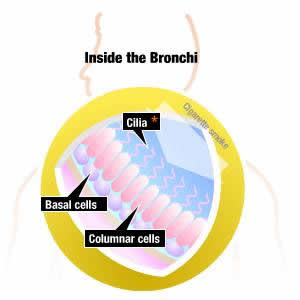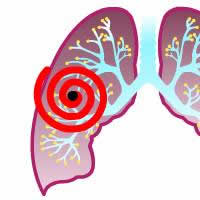Lung Cancer
Help on accessing alternative formats, such as PDF, MP3 and WAV files, can be obtained in the alternate format help section.
Flash Animation of lung cancer effects
Early detection nearly impossible
How smoking damages your lungs
How smoking causes cancer
Treating lung cancer
Anyone can be a victim
 More than 45,000 people in Canada will die this year from all tobacco-related diseases and many of these deaths will be caused by lung cancer. Although other factors can cause lung cancer, smoking is responsible for 85% of all new cases. More than 45,000 people in Canada will die this year from all tobacco-related diseases and many of these deaths will be caused by lung cancer. Although other factors can cause lung cancer, smoking is responsible for 85% of all new cases.
Early detection nearly impossible
 Lung cancer develops when a group of abnormal cells begins to multiply forming lumps called tumours. Malignant tumours are often fatal. Often there are no early symptoms and there are no techniques that can detect it at any early stage. Lung cancer can spread to other parts of the body. Lung cancer develops when a group of abnormal cells begins to multiply forming lumps called tumours. Malignant tumours are often fatal. Often there are no early symptoms and there are no techniques that can detect it at any early stage. Lung cancer can spread to other parts of the body.
How smoking damages your lungs

Tobacco smoke contains at least 50 known cancer-causing agents. Over years of smoking, tar** collects and forms a sticky layer which reduces the ability of the lungs to get rid of harmful particles and helps retain the carcin-ogens present in tobacco smoke.
This tar build-up impairs the cleansing membranes of the lungs resulting in excess mucus. The common “smoker’s cough” is evidence that the body is attempting to clear the lungs of harmful waste.
*Cilia are the cleansing membranes that help protect the lungs from contaminants
**Tar is a generic term used to designate the collection of 3800 to 4800 different chemicals
How smoking causes cancer
The development of lung cancer is probably the result of irritation caused by smoking and the accumulation of chemical dusts and particulates. Irritation, when constantly stimulated, triggers inflammation and this brings about a destruction of the lung’s cleansing membrane. The replacement scar tissue does not have the same ability to neutralize the harmful cancer-causing particles inhaled in smoke and this leads to the development of cancer cells which can multiply and replace healthy ones.
Treating lung cancer
 Treatment generally consists of an operation to remove the cancer (resection) when possible and may involve chemotherapy or radiation to the head to minimize brain metastasis (the transfer of cancer cells from one part of the body to another). Once diagnosed, 60% of patients will die within one year and fewer than 15% will survive five years. Treatment generally consists of an operation to remove the cancer (resection) when possible and may involve chemotherapy or radiation to the head to minimize brain metastasis (the transfer of cancer cells from one part of the body to another). Once diagnosed, 60% of patients will die within one year and fewer than 15% will survive five years.
Anyone can be a victim
 If you smoke, or if you are regularly exposed to second-hand smoke, you are breathing in carcinogens like tar, benzene and formaldehyde. For smokers, the best prevention is to quit. Non-smokers should avoid second-hand smoke and protect children from this hazard. This year in Canada, more than 300 non-smokers and an estimated 13,000 smokers will die from lung cancer caused by tobacco smoke. If you smoke, or if you are regularly exposed to second-hand smoke, you are breathing in carcinogens like tar, benzene and formaldehyde. For smokers, the best prevention is to quit. Non-smokers should avoid second-hand smoke and protect children from this hazard. This year in Canada, more than 300 non-smokers and an estimated 13,000 smokers will die from lung cancer caused by tobacco smoke.
More information
|
